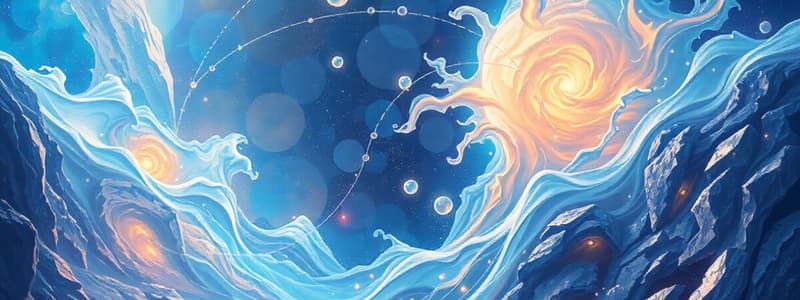Podcast
Questions and Answers
What describes the behavior of liquid particles compared to gas particles?
What describes the behavior of liquid particles compared to gas particles?
- Liquid particles are fixed in place and do not move.
- Liquid particles are widely spaced and move randomly.
- Liquid particles are close together but can move past each other. (correct)
- Liquid particles have a definite volume but no shape. (correct)
Which statement about gases is correct?
Which statement about gases is correct?
- Gases have particles that are fixed in place.
- Gases expand to fill their containers. (correct)
- Gases are incompressible under pressure.
- Gases have a definite volume and shape.
How does the shape of a liquid differ from the shape of a solid?
How does the shape of a liquid differ from the shape of a solid?
- Liquids take the shape of their container, while solids do not. (correct)
- Liquids retain a definite shape regardless of their container.
- Liquids can be easily compressed like gases.
- Liquids have a fixed shape that changes with temperature.
Which of the following is true about the compressibility of liquids?
Which of the following is true about the compressibility of liquids?
What characteristic of gas particles allows them to flow more easily than liquid particles?
What characteristic of gas particles allows them to flow more easily than liquid particles?
Flashcards
Liquid
Liquid
A state of matter with a definite volume but no definite shape.
Gas
Gas
A state of matter with neither definite volume nor shape, expanding to fill its container.
Shape
Shape
The external form or outline of an object, describing its spatial arrangement.
Properties of Liquids
Properties of Liquids
Signup and view all the flashcards
Properties of Gases
Properties of Gases
Signup and view all the flashcards
Study Notes
Liquid
- A liquid is a state of matter that has a definite volume but no definite shape.
- Liquids take the shape of their container.
- Liquid particles are close together, but they are not fixed in place. They can move past each other.
- Liquids are relatively incompressible. A large amount of pressure is needed to reduce their volume.
- Liquids flow easily.
- Examples of liquids include water, milk, juice, oil, and mercury.
Gas
- A gas is a state of matter that has neither a definite volume nor a definite shape.
- Gases expand to fill their containers.
- Gas particles are widely spaced and move randomly and rapidly in all directions.
- Gases are highly compressible. Their volume changes significantly with pressure changes.
- Gases flow easily like liquids but much faster, as there is less interaction between particles.
- Examples of gases include oxygen, nitrogen, carbon dioxide, and helium.
Shape
- Shape refers to the external form or outline of something.
- Shape describes the spatial arrangement of points or lines composing a solid object or two-dimensional figure.
- The shape of an object can be regular (e.g., a square) or irregular (e.g., a cloud).
- Shape can be described in various ways, including geometric terms (e.g., rectangular, circular) and descriptive terms (e.g., pointed, rounded).
- The shape of a liquid is determined by the shape of its container; it conforms to the container.
- The shape of a gas is also determined by the shape of its container; it expands to fill the container.
- The shape of a solid is independent of its container and retains its fixed shape.
Studying That Suits You
Use AI to generate personalized quizzes and flashcards to suit your learning preferences.




